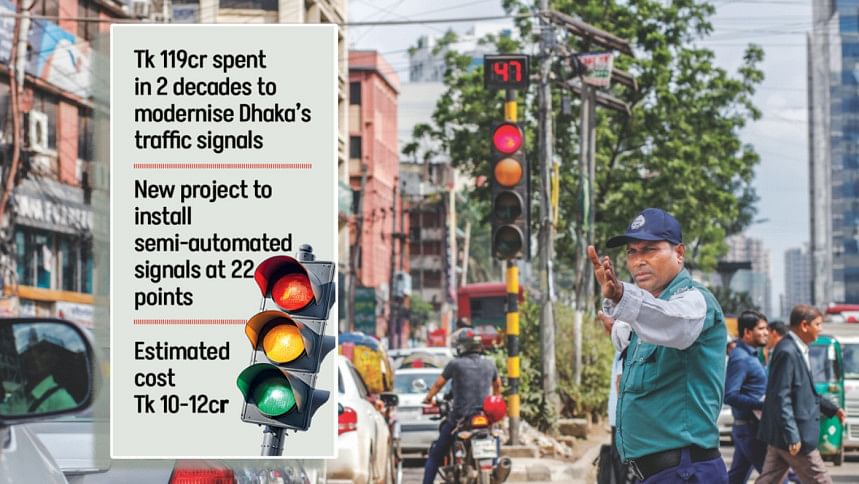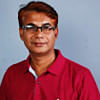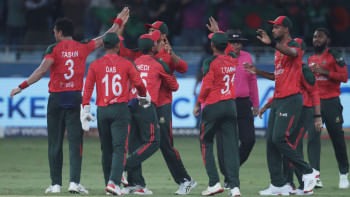Dhaka to get semi-auto signals to tackle jam

The government is likely to introduce a semi-automatic system of traffic lights at 22 busy intersections between Kadam Foara and Abdullahpur in the capital to reduce congestion and reliance on traffic police.
The initial plan was to introduce the system at four intersections on March 16, but it was deferred by a week due to the visit by the UN secretary-general, says Neelima Akhter, executive director of Dhaka Transport Coordination Authority (DTCA), which leads the initiative.
"Traffic management should not be left to police officers waving their hands at intersections," she says, underscoring the necessity of transitioning to an automated system.
The system will cost between Tk 10 crore and Tk 12 crore, according to officials at Dhaka North City Corporation (DNCC).
The move follows a two-decade-long struggle to implement an efficient system of traffic management. Over the years, the authorities spent over Tk 119 crore on modernising the equipment, but Dhaka traffic is mostly managed manually.
Under the new initiative, DNCC will oversee 14 intersections and Dhaka South City Corporation eight.
In the beginning, DSCC will install lights at the intersections near InterContinental hotel and Banglamotor, and DNCC at Saarc Foara roundabout and Farmgate.
Whether more places will see the change will depend on the outcome of the lights at the four intersections, officials say.
There will be a switch at the traffic police booths, allowing officers to toggle between automatic and manual modes. Cameras and loudspeakers will be installed for better enforcement, they add.
ENDLESS TAILBACKS
On a recent afternoon at the Sergeant Ahad Police Box in Gulistan, one of the Dhaka's busiest intersections, an officer was struggling to manage the countless cars, buses, and rickshaws.
He was using a piece of rope when he needed to stop the flow.
Across the city, pedestrians dart across streets amid moving traffic, motorcyclists risk their lives jostling for space, and motorists park near schools and hospitals.
Jaywalking, the lack of crosswalks, inadequate number of footbridges, illegal parking, and rickshaws weaving through traffic are obstacles to the flow, officers say.
A sergeant, requesting anonymity, says there are simply too many vehicles to keep the vehicles moving.
"VIPs, politicians, and even law enforcement personnel often disregard the rules, making the general public unwilling to abide by the laws," says an officer.
Transport expert Prof Shamsul Hoque says nothing would succeed without proper enforcement.
"You can launch as many projects as you want. But without proper enforcement, both automatic and semi-automatic systems will fail," he says.
For traffic lights to work, there must be enough pedestrian infrastructure like footpaths, and BRTA, the road transport authority, must regulate the number of vehicles, he adds.
The junctions at Gulshan-2, Hatirjheel, and Dhaka Cantonment seem orderly because of strict enforcement, he says.
"In Gulshan, there are no rickshaws, easy bikes, or erratic buses."
EARLIER ATTEMPTS
In the last 20 years, the authorities installed automatic lights, countdown timers, digital displays, and even AI-aided systems at major intersections spending over Tk 119 crore. But nothing reduced the length of tailbacks.
Automatic traffic lights installed between 2001 and 2005 went out of order allegedly because of poor maintenance.
In 2012 and 2013, DSCC revived the system, but it barely lasted a month.
At one point, police used remote controls to operate the lights. But that system also fell apart.
Digital displays showing directions were largely ignored by motorists.
In 2023, a Tk 62 crore AI-assisted system also failed to deliver.
It was first installed at Gulshan-2 at a cost of Tk 60.47 lakh. But it did not make much impact.
At other intersections, police had to manually control traffic during peak hours. The DSCC later conducted a feasibility study at 54 intersections, and scrapped the initiative in July last year.
Prof Shamsul says without trained personnel and a fundamental shift in discipline, future projects are likely to meet the same fate as previous ones.
The cantonment area can be a model because traffic lights have functioned effectively for over two decades, he says.
"The number of vehicles must be proportionate to road space. The government should discourage car ownership and invest in better public transport."
BRTA's poor regulatory oversight needs to change too, he says.


 For all latest news, follow The Daily Star's Google News channel.
For all latest news, follow The Daily Star's Google News channel. 





Comments